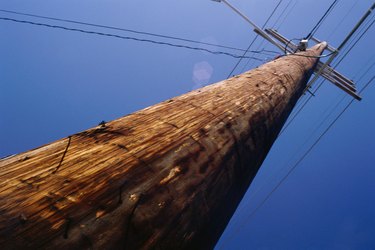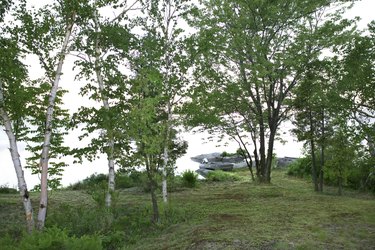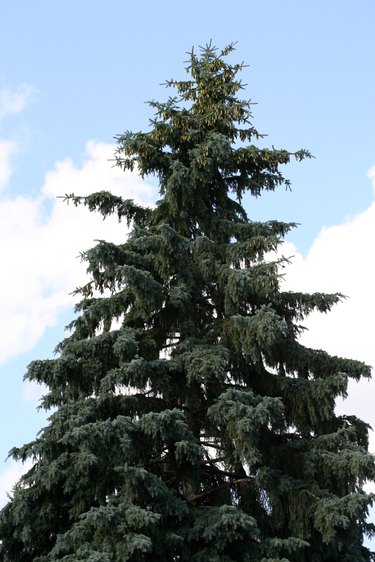
Most gardens contain at least one element that's less than ideal, but few things are as awkward to work around than electrical poles. Ideally, a landscape plan should screen the pole from view without interfering with the lines or the pole itself and still allow access to the pole for maintenance. There are a number of approaches you can take to disguise these eyesores.
Step 1

Use a wooden electrical pole as a support for evergreen or flowering vines, if your utility company and local government allow it. Choose a vine that never gets as high as the point where the lines attach to the poles. A vine that twines is a better choice than one that clings with adhesive suckers because the vine will only grow as tall as the wire or trellis you plant it against. Large-flowered clematis (Clematis hybrids), goldflame honeysuckle (Lonicera x heckrotti) and climbing roses (Rosa ssp. and hybrids) are good choices that stay under 12 to 15 feet.
Video of the Day
Step 2
Create a conifer garden in front of the electrical pole. Like the magician's trick of diverting your attention, the focus will be on the garden in front of the pole and not on the pole itself. Since conifers keep their foliage all year, the pole becomes less noticeable year-round. Use a variety of shapes and sizes so that the garden is interesting from all directions.
Step 3

Plant a cluster of three to five deciduous trees between your house or patio and the electrical pole. This creates a naturalistic screen to hide the pole. However, make sure the trees have enough headroom that their branches won't grow near the overhead wires. Trees such as birches (Betula spp.) have interesting bark that's attractive in the winter, too.
Step 4

Plant a large, conical evergreen in front of the pole. Choose a variety that grows taller than the pole or that will look taller from your vantage point. In a few years, the evergreen will be the dominant feature, not the pole. American hollies (Ilex opaca), arborvitae (Thuja spp.) and Canadian hemlocks (Tsuga canadensis) all make good screens. Just make sure to site the tree so that no matter how tall it gets, it won't encroach on the electrical wires.
Tip
Before beginning any landscaping near electrical poles, call the utility company and ask for advice. Wait until they send someone to mark the location of underground wires before you start digging. In addition, in some jurisdictions you can only plant grass or nonclimbing ground covers around the pole for easy maintenance. Height restrictions for trees are common, too; respect those restrictions or you may unexpectedly find workers trimming your trees one day.
Warning
Never climb an electrical pole to trim vines or attach a support. Only properly outfitted utility workers should climb the poles.
Video of the Day
- University of Florida IFAS Extension: Disguising Utilities
- University of Florida IFAS Extension: Screening Undesirable Views
- Penn State Cooperative Extension: Using Trees and Shrubs for Privacy and Wind Screening
- Clemson Cooperative Extension: Vines
- Colorado State University Extension: Evergreen Trees